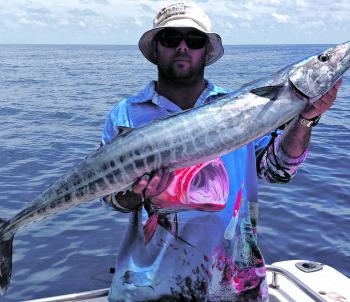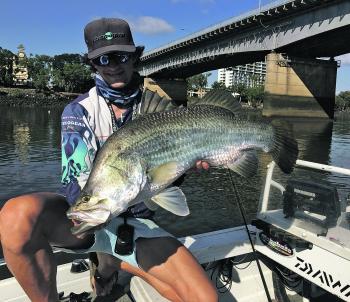Winter is snapper time. They started off slowly, as they travel into shallow waters in the coldest months. It usually takes a cold snap to bring them right in close, which has just happened.
Rubble or reefy patches, around 20m and deeper, are the best spots this month. They will come in to feed in the shallow spots like Conical, Outer, Forty Acre and Ross Reef and the patches just out from the main islands.
I have found that they can be quite shy in the shallow water and you need to fish light to get any regular catches. I position the boat back from the area I want to fish and float down the bait with the smallest possible lead. Fresh bait is best and snapper respond well to berley. Pillies, prawns, mullet strips and squid have been our choice baits.
Huge red emperor and large-mouth nannygai have been in exceptional numbers in recent weeks. Much of the rubble and fern country is turning up good numbers of these great fish. Although there are good fish at all the regular spots, it’s worth searching away from them to get the snodgers. Reds take mostly big fresh or live baits. If you use bigger baits, it gives the larger fish time to get a feed before the rubbish fish pick you dry. Lately some of the best fish have been caught on old octo jigs with a big paddle-tail on the keeper hooks.
The schools of greenbacks or yorky herring and white bait have started travelling along the beaches and up the coast. With them come the small mackerel, bonito and blue salmon. Whenever we get the chance to score some of the big greenbacks, it pays to keep some alive or pack them flat to freeze for either mackerel or reefies. From now on, if the weather allows, the mackerel will be at the many spots very close to Yeppoon and Emu Park, depending on water clarity.
All the headlands from Keppel Sands to Yeppoon have the lesser mackerels, doggies or greys, in July. The places to try are Stevensons Point, the Rosslyn Bay Harbour wall and the Bluff, the Keppels, Forty Acre Paddock, Conical Rocks, Outer, Man and Wife, Half Tide Rocks, Rita Mada, Iron Pot, Farnborough, Bangalee, Claytons, the Septic Tank, Pelican, Wedge, Divide, Cave and Quartz.
Once again the preference of baits or lures is up to the angler. We find that you can get more hits in less time with lures, and often the bigger fish will take a floating pilchard. Most chromies with a bit of action can catch mackerel. These days I have reduced my selection to two that work all the time.
Pillies can be floated out unweighted when the current is slow, and early in the morning. As the sun and the current rise you can add a pea sinker to get them down to the right depth.
Spanish mackerel have been doing very well recently and the fish have been a bit bigger than the size we were getting last month. Big tides are usually the best at most spots. Barron, Man and Wife, Outer, Big Peninsula, Liza Jane, Conical, Manifold, Flat and Perforated are all Spaniard hotspots. At this time of year all the rubble reef patches will hold Spanish mackerel. The best tip is to fish a high tide before lunch time. They will take lures or baits.
Spanish start near the surface on sunrise and move down the water column as the sun gets higher. Lately when we’ve been chasing mackerel there have been some average-sized wahoo with them. Some of the offshore rubble patches are attracting wahoo in numbers like we haven’t seen before. To target wahoo, I usually troll a bit quicker than I would for Spanish. They will take a well-presented live floater or a dead bait as long as it is hanging like it is alive.
Black jewfish have continued to bite this month and should for the next month or so. Black jewfish rate among the larger fish caught in winter, and the local reports show captures of jewies up around 20kg or a bit bigger. The most common size is in the 10-15kg class. Ironpot, Double Heads, Corio Heads, Rita Mada, Findlays, Quartz, Pelican and Cape Capricorn are the top spots at the moment.
Grunter have remained steady in local captures and will be around whenever the weather allows for an evening trip. They do get caught during the day at times, but the evening on a rising moon is by far the best. All the black jewfish spots are also grunter spots.
The cold snap has hit us at last. As temperatures plummeted, most of the estuary fishing slowed for a day or two before picking up again. The exceptions were bream and flathead, which lifted in numbers right across the area. The big bream have been congregating near the creek mouths and bays around rock bars and deeper mangrove banks. Flatties have been mainly in the deeper channels adjacent to the mud and sand flats. Several times in recent weeks we have picked up flathead right in the middle of thick timber while targeting barra and jacks.
The big king threadfin schools that were with us over the warmer period have broken up and spread into more areas. They are still pretty active just below the town reaches and right down into the delta. Threadies chase fiddler crabs in very shallow water and gutters. They smash their heads into the mud leaving large dents. Fresh workings all have sharp edges on the dents and as more tides move in and out the edges round off.
People often mistake salmon workings for crab holes, so it pays to get in close and have a look. Threadies will take livies or the right kind of lures. When they were in the bigger schools you could use virtually any vibes or hardbodies and still have success. Lately they are a bit more fussy and using smaller prawn type plastics and crab imitations is producing good catches.
Barramundi are still in good shape as the days get even cooler. They have been most active in town and down towards Port Alma in the Fitzroy River. The consistent size of these fish is amazing since the introduction of the NFZ. Anglers fishing from the banks in town are mostly using live silver perch or mullet. The guys fishing everywhere else are producing barra using mainly vibes and big paddle-tail plastics.
Reads: 3870
Craig Robertson showing a large pikey bream.

Connor Duffy from Frogleys Offshore scored this top red wide of Yeppoon.

Fabian Sutton scored his first wahoo on a recent trip.

Charlie Hohn about to release a nice town barramundi.




